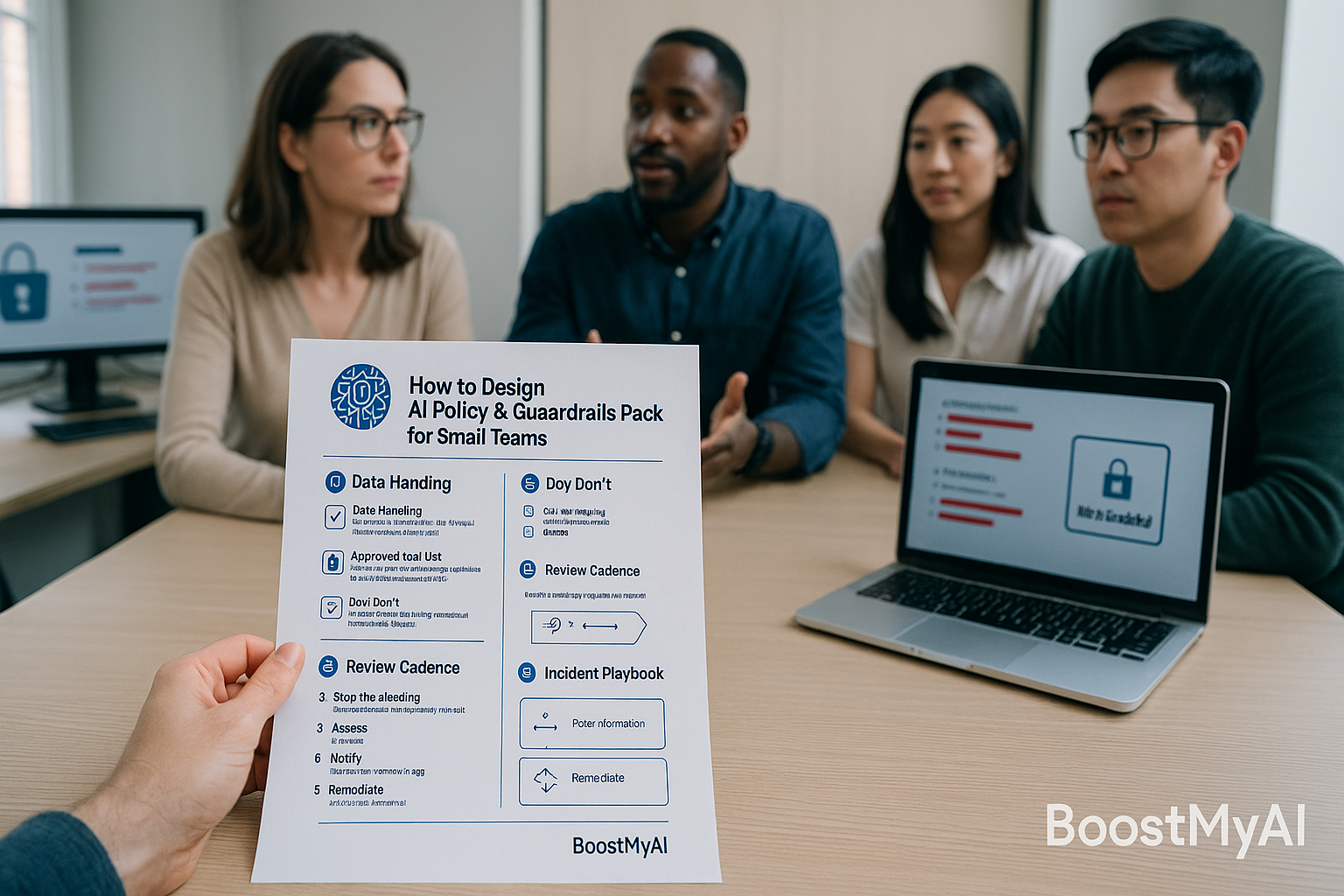How to Design an AI Policy & Guardrails Pack for Small Teams
Small teams don’t need a 20-page policy no one reads. You need one clear page that sets boundaries, speeds up approvals, and keeps you out of trouble. Here’s a practical build you can finish in an afternoon and roll out tomorrow.

What this covers
- Data handling: What can/can’t be shared with AI tools—and how.
- Approved tool list: The only apps your team should be using.
- Do / Don’t rules: The quick-scan commandments.
- Review cadence: When and how this page gets updated.
- Incident playbook: What to do when something goes sideways.
1) Data Handling (keep it simple, keep it safe)
Classification
- Public: okay to paste (marketing copy, published docs).
- Internal: okay with approved tools if redacted (project codes, non-sensitive SOPs).
- Confidential: never paste (customer PII, financials, legal docs, credentials).
- Regulated (PHI/PCI/ITAR, etc.): never paste; follow system-of-record only.
Guardrails
- Strip names, IDs, contract $ amounts, and any unique identifiers.
- Use read-only links in prompts instead of uploading files when possible.
- Store outputs in your company drive, not personal devices.
- For training data: use sandbox/test data or synthetic examples only.
Minimum Security Settings
- Enforce SSO + MFA for all AI tools.
- Disable “Use data for training” where possible.
- Log who used what tool and when (basic audit trail).
2) Approved Tool List (the only tools that count)
Keep this tight; expand later as needed.
Create/Generate
- Writing: Company-approved ChatGPT/Microsoft Copilot account
- Images/Video: [Your chosen tools here]
Analyze/Automate
- Sheets/Docs add-ins: (e.g., Microsoft 365 Copilot, Google Duet)
- Automation: (e.g., Zapier/N8n instance owned by the company)
RAG/Knowledge
- Internal search/FAQ bot connected to your drive with least-privilege access.
Requests for New Tools
- Use a 3-question form: (1) Business outcome? (2) Data touched? (3) Who owns it?
- Default trial: 2 weeks, limited scope, then keep or kill.
3) Do / Don’t (the no-thinking checklist)
Do
- Ask AI to draft, outline, summarize, or QA—not to decide for you.
- Redact sensitive details; describe the pattern instead of pasting raw data.
- Keep the human-in-the-loop: review tone, claims, math, and citations.
- Label AI-assisted work: “Drafted with AI; reviewed by [Name], [Date].”
- For external content, run a quick fact check against primary sources.
Don’t
- Upload customer PII, credentials, contracts, or unreleased financials.
- Use unapproved browser extensions or personal accounts.
- Put AI outputs straight into production or send to clients without review.
- Claim AI-generated content is entirely human-written.
4) Review Cadence (version control for sanity)
- Weekly (5 min): Tool list changes + incident log check.
- Monthly (15 min): Spot-check outputs for accuracy and bias; refresh examples.
- Quarterly (30–45 min): Update the one-pager; re-train the team; confirm access/MFA/audit settings.
- Owner: Name + role. Back-up: Name + role. Version: YY.MM.DD.
5) Incident Playbook (what to do when something leaks—or might)
- Stop the bleeding
- Revoke tokens/keys, disable the app/session, rotate credentials.
- Contain & assess
- What data, whose data, which tool, who touched it, when?
- Notify
- Internal: Owner + leadership immediately.
- External: Customers/regulators only via leadership/legal.
- Remediate
- Remove exposed files, update permissions, add missing guardrails, retrain.
- Post-mortem (24–72 hrs)
- What failed, what changes, who owns follow-ups, by when.
- Log the incident on the one-pager (date + 1-line summary + fix).
How to Roll This Out (fast)
- Draft this page with your actual tools and examples (10–20 minutes).
- Share in Slack/Teams with a 3-minute Loom walkthrough.
- Run a 15-minute live training: demo redaction, show an approved prompt, review the incident steps.
- Pin the one-pager in your team hub; require “AI-assisted” label in deliverables.
- Calendar the monthly/quarterly reviews.
One-Pager Template (copy/paste)
Title: [Company] AI Policy & Guardrails (vYY.MM.DD)
Owner / Backup: [Name/Role] / [Name/Role]
Data Handling:
- Public ✅ | Internal (redact) ⚠️ | Confidential/Regulated ❌
- Never upload: PII, contracts, credentials, unreleased financials.
- MFA required; disable training; outputs saved to [Drive/Folder].
Approved Tools:
- Gen: [Tool] | Analyze: [Tool] | Automate: [Tool] | RAG: [Tool]
- New tool request: link to 3-question form.
Do / Don’t:
- Do: draft/outline/QA; redact; label “Drafted with AI; reviewed by [Name].”
- Don’t: paste sensitive data; use personal accounts; publish without review.
Review Cadence:
- Weekly check, monthly QA, quarterly update & training.
Incident Playbook (TL;DR):
- Stop → Assess → Notify (internal → legal) → Remediate → Post-mortem.
- Incidents log: [Link].
Examples (keep 2–3 live):
- Good prompt: “Summarize this SOP into a 7-step checklist; exclude client names; output in bullets.”
- Redaction example: “ACME-12345 → [Client-ID]; $45,000 → [Amount].”
FAQs (30-second answers)
- Can I use my personal ChatGPT account? No—company account only, with MFA.
- Can I upload client reports? Only if fully redacted and classified “Internal.”
- Who approves new tools? The policy owner; 2-week trial; keep/kill decision logged.
- What if I’m not sure? Don’t paste it. Ask the owner in the same thread.
The payoff
You’ll reduce “Can I use this?” questions, cut risk from shadow tools, and ship more polished work—without slowing anyone down.
Ready to ship your AI Policy & Guardrails Pack?
Contact BoostMyAI to get started: we’ll tailor this one-pager to your stack, wire in the right defaults (SSO/MFA, logging, redaction patterns), and run a 30-minute rollout with your team.
